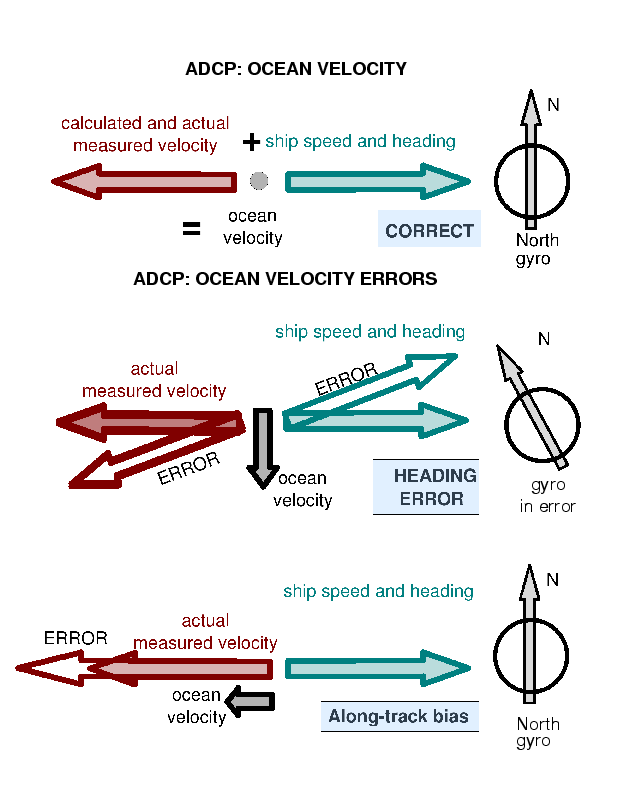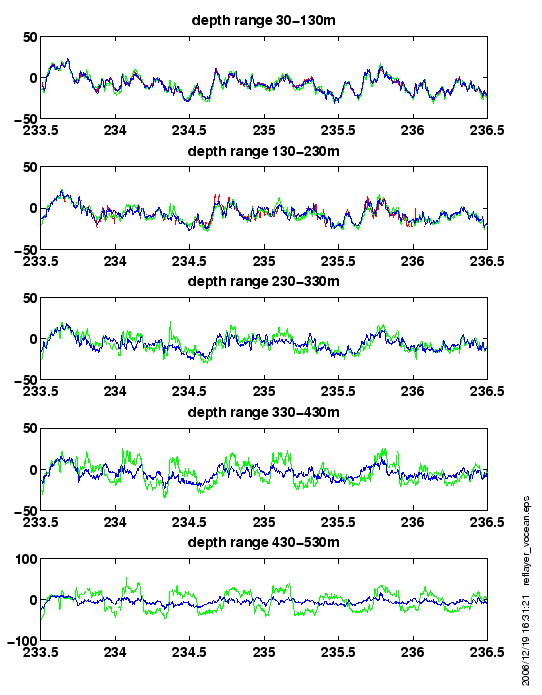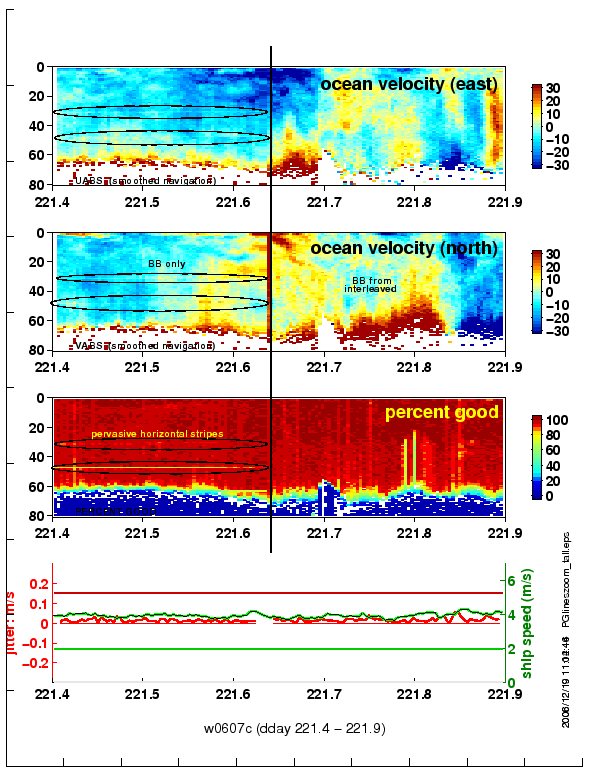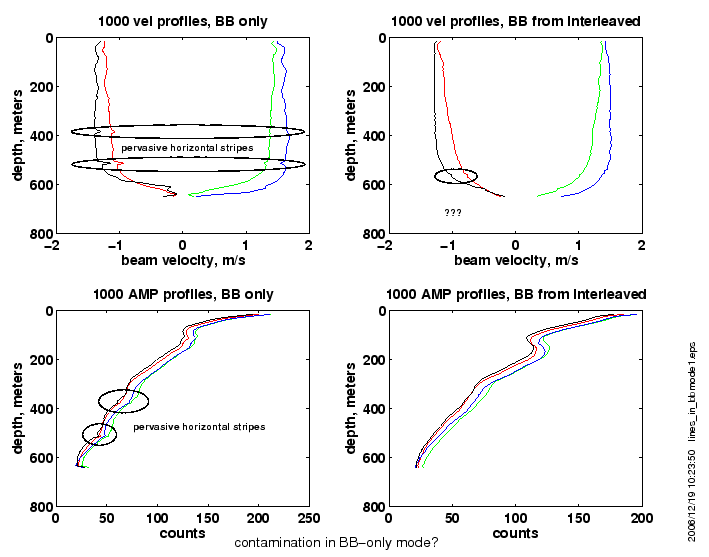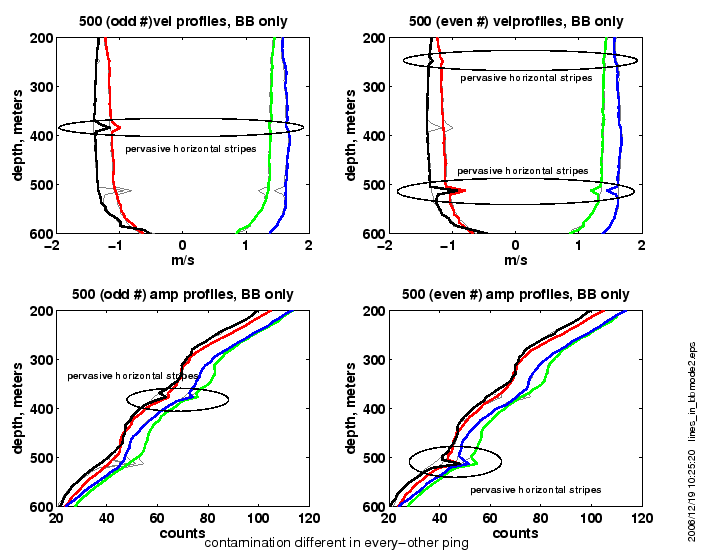R/V Wecoma R.D.Instruments 75kHz Ocean Surveyor ADCP broadband mode is
degrading. The purpose of this document is to pull together the
information on the Wecoma OS75 health so that action can be taken to
resolve the problem, and so that scientists using data from the Wecoma
know what to expect from this instrument.
R/V Wecoma had an RDI OS75 ADCP installed in the 2002/2003 time frame.
From the time of installation until January 2005, data were collected
with the software RDI provided for use with Ocean Surveyors ("VmDAS").
In January 2005, the Wecoma spent several months in the vicinity of
the Hawaiian Islands. During that time we (Eric Firing group at
University of Hawaii) provided a laptop running our own data
acquisition program ("UHDAS") and provided real-time and post-cruise
help with data processing. Our software was written to take advantage
of the Ocean Surveyors' capability of interleaved broadband+narrowband
pinging. Subsequent processing of the two datasets (BB and NB) showed
that both modes required an unusually high (1.01) scale factor be
applied to the measured velocities to remove along-track contamination
proportional to ship speed.
The UHDAS laptop was removed from the ship in March 2005, and a
permanent UHDAS computer was installed in March 2006. Shore-based
monitoring of a UHDAS installation is made possible by daily emails
with a subsample of processed data and various diagnostic information.
With data coming in from the new UHDAS installation, it was obvious
that the OS75 amplitude calibration was not the same as it had been in
January 2005. In order to understand the character of the OS75
calibrations, data from a cruise that took place in Aug 2006 were
processed to look at the calibrations in more detail. This cruise
included interleaved and broadband-only pings, as well as some
bottom-track data. In addition, much of the samping was done with a
"mow the lawn" cruise track, i.e. running relatively short, parallel
cruise tracks, to map bottom topography or thoroughly survey a box of
water. Alarming characteristics were seen, especially in the OS75
broadband mode.
Two common sources of error in ADCP ocean velocity calculations are
the total angle used to transform beam coordinates to earth
coodinates, and the extent to which the measured velocities are
consistently too small or too large. These errors are nearly
independent, with the angle error primarily affecting cross-track
velocity component and the scale factor affecting along-track
component.
Heading errors on the Wecoma are addressed by transforming beam
coordinates to earth using gyro headings, and then correcting ensemble
headings by the average difference between the Ashtech and the gyro.
The Ashtech works well on the Wecoma, so this is satisfactory.
Small scale factor errors are common with fixed-transducer ADCPs
such as the old Narrowband or newer WorkHorse (broadband) if the
wrong speed of sound was used during acquisistion or processing.
This can occur if the thermistor is broken or if the speed of sound of
the fluid surrounding the transducers is not well-predicted by
temperature alone.
|
Note
|
Phased array transducers should not require a scale factor. |
The following figure illustrates the way in which angle and scale
factor errors result in cross-track and along-track errors,
respectively.
A random collection of Wecoma cruises were processed to
the extent of determining their scale factor and ping type.
The data appear to start out well, with 2003 BB mode showing no
scale factor necessary. In early 2005, BB mode in interleaved
requires about 1-1.5% (1.01-1.015) scale factor, NB mode is
still OK. In Aug 2006, bb mode requires 5%, nb still requires 1%.
So, it seems that perhaps both modes are deteriorating; certaily BB
mode is degrading. Bottom track seems to follow NB mode.
Table: Scale factor calibrations Wecoma (number of points is in parentheses)
|
|
water(BB)
|
water(NB)
|
botmtrk
|
|
w0306
|
1.00(72)
|
-----
|
1.00(2399)
|
|
|
|
|
|
|
|
|
|
|
|
|
|
|
|
|
w0501bc
|
1.012
|
1.003
|
---
|
|
w0503_wu
|
1.01
|
1.00
|
---
|
|
|
|
|
|
|
w0505c
|
1.17(46)
|
-----
|
1.01(815)
|
|
w0508b
|
|
1.012(11)
|
---
|
|
w0509a
|
|
1.01(45)
|
1.02 (74)
|
|
w0510a
|
|
1.01(5)
|
1.01
|
|
|
|
|
|
|
|
|
|
|
|
|
|
|
|
|
w0607c
|
1.056(176)
|
1.01(145)
|
1.01(29)
|
Amplitude calibration calculation was carried out for all three
instruments, wh300, os75bb, and os75nb. The calculation was repeated
with relatiively thin reference layers at a variety of depths to see
whether there was any kind of depth depencence in the value. No
vertical trend is visible for wh300. The OS75nb profile shows a
rather noisy but relatively constant value of 1.008, increasing at the
surface and deepest range. OS75bb mode is close to 1.055 near the
surface but increases below about 200m to very large values (1.10)
"Processing" ADCP data typically allows the use of one scale factor
for all depths. The OS75 broadband mode still has large (1.06) scale
factor required in its lower range, so below about 200m, ocean velocities
in the along-track direction are incorrect. This figure shows the
northward ocean velocity as the cruisetrack "mows the lawn" going
north and south. As the depth range for comparison gets deeper, the
os75bb (green) deviates from the os75nb (blue) in a predictable
manner. The bias in deeper depths is in the along-track direction, so
positive errors occur during northward transits, and negative errors
occur during southward transits.
One unexplained data artifact seems to exist only in the segment where
the instrument was configured to collect broadband mode data (not
interleaved). Characteristics include:
(1) a bump in the ACG profile, as if there were acoustic interference
that occurs with a regularity that results in different aliasing on odd
and even profile numbers
(2) does not obviously exist in either BB or NB mode when the data
are interleaved
(3) the AGC spike is relatively weak, but is stronger in 2 beams
(1 and 4) than in 2 and 3
(4) the spike in velocity is towards zero in beam velocities
(5) the velocity spike and amplitude spike do not occur in the NB mode
of interleaved acquisition.
(6) The ACG spike does not seem large enough to cause this large
a spike in velocity, and usually a bump in AGC causes an "S" in
the velocity profile, not a spike towards zero
(7) This is not a previous-ping problem: the spikes are too narrow,
and the ocean floor is deep but variable during the period.
The figure below shows ocean velocity east and north, percent good,
and estimated ocean depth, of the BB dataset collected during a
12 day period. The first 2 days are BB from interleaved, the next 7 days
are BB only (note the perpvasive stripes in PG), and the last 3 days
are again BB from interleaved. The stripes in PG are a result of
single-ping editing that removes velocities which occur at the
location of an AGC spike.
The next figure zooms in on the transition between BB-only (left) and
BB-during-interleaved (right). Subtle but persistant stripes in
velocity are correlated with the PG stripes. Figure quality may not
make the problem obvious in this figure.
The figure below zooms in on the transition from BB-only to
interleaved mode by examining the beamwise data from the nearest 1000
pings to the transition on either side. The left panels show profiles
from 1000 pings collected at 2-second intervals with BB only mode
and the BB mode pings from the following 1000 ensembles
which were collected in interleaved mode. There is a 3-minute gap
between these datasets. It is difficult to identify the presence of
the spikes in the BB-from-interleaved mode profiles, but they are
obvious in BB-only data.
It is possible the scientists coordinated
things to turn off an acoustic device at exactly the boundary between
the BB-only acquisition and interleaved acquisition.
The last figure in this set illustrates the strange timing of the
spikes. For BB-only mode, for odd-numbered ensembles, the spikes are
at about 380m, and possibly in the strongly biased region where the
signal degrades below 600m (not visible for these profiles). For the
same dataset, but the even ensembles only, the spikes are at about 240m
and 520m. The depth spacing suggests an acoustic device with a
relatively constant high repeat-rate, but its characteristics are
unusual (shape of velocity spike compared to amplitude spike) and it
seems strange that it would disappear exactly when interleaved mode was
turned on.
The OS75 on the Wecoma requires a substantial scale factor for BB, NB,
and bottom track modes. This was not true when the instrument was
installed. The gradual development of this increasing scale factor
suggests a deterioration of some part of the OS75 itself, not a sudden
catastrophic event. The BB mode appears to be failing more
dramatically then NB mode. Large scale factors and strong vertical
dependence are present for BB mode whether aquired alone or as part of
an interleaved ensemble. An artifact resembling acoustic interference
was present during the entire BB-only acquisition segment, and was not
obvious at any other time.
Tests:
-
The deck unit was swapped out for one quick cruise, and the scale
factor for BB mode was still high (this is not a deck unit problem)
-
Once the ship is in deep water, the artifact seen in cruise w0607c
can be investigated more thoroughly by collecting data under
different acquisition modes with other acoustic instruments
being secured
The OS75 should probably be sent back to RDI for investigation and
some kind of recommendation for refurbishment, repair, or replacement.
Upcoming cruises on the Wecoma depend on the ADCP data as part of
their science mission, and at the moment, the OS75 is unhealthy.
